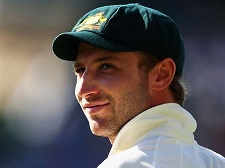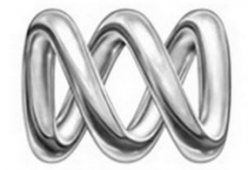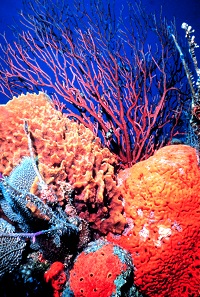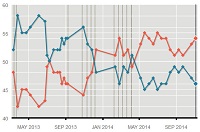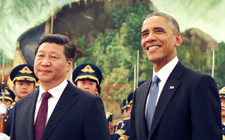Big Red is the last and biggest of over 1100 sandhills you have to cross in a west-east crossing of the Simpson Desert. Standing some 34 metres above the plain it presents a considerable challenge. Here is what it looked like to us coming down the penultimate sandhill: Continue reading Simpson Desert crossing 7: Big Red
Monthly Archives: November 2014
Saturday salon 29/11

An open thread where, at your leisure, you can discuss anything you like, well, within reason and the Comments Policy. Include here news and views, plus any notable personal experiences from the week and the weekend.
For climate topics please use the most recent Climate clippings.
The gentleman in the image is Voltaire, who for a time graced the court of Frederick II of Prussia, known as Frederick the Great. King Fred loved to talk about the universe and everything at the end of a day’s work. He also used the salons of Berlin to get feedback in the development of public policy.
Fred would only talk in French; he regarded German as barbaric. Here we’ll use English.
The thread will be a stoush-free zone. The Comments Policy says:
The aim [of this site] is to provide a venue for people to contribute and to engage in a civil and respectful manner.
Here are a few bits and pieces that came to my attention last week.
1. Vale Phillip Hughes
Cricket will go on, but when we’re ready.
That’s the message from the game’s leaders today as grief envelops the sport here and abroad.
Teams and individuals are paying tribute to Philip Hughes in their own ways and will continue to do so at games this weekend.
Some clubs will paint 63 on their ovals – marking that he was 63 not out when he was hit by that ball.
The outpouring has also been extended to bowler, Sean Abbott.
A test is due to get underway next week but at this stage cricket administrators say no one is in a position to make a decision as to if or how that will proceed.
Various sporting codes are honouring him in their own way. A state memorial service will be held at the Sydney Cricket Ground, with date and other details to be confirmed. The notion of putting out your bats has gone viral:
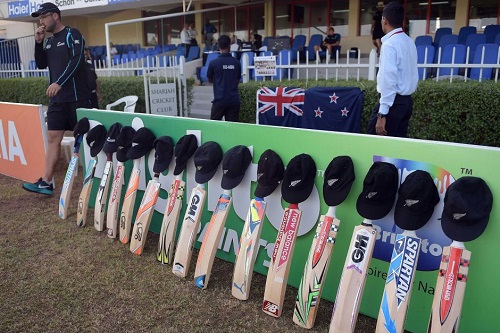
Like Steve Waugh, I think he should have never been dropped. He was dropped five times in 26 tests. Waugh points out that he, Waugh, took 26 tests to score his first ton.
Our sympathies to his family and all who knew him. He obviously touched many hearts in a positive way.
2. Sturm und Drang in Brisbane
That’s “storm and stress” BTW.
A savage storm lashed Brisbane City on Thursday afternoon. Here it is as captured on social media. More images of the aftermath here.
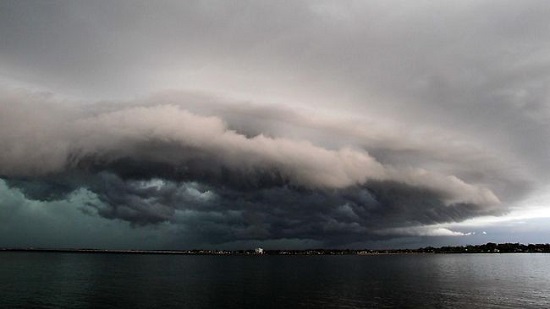
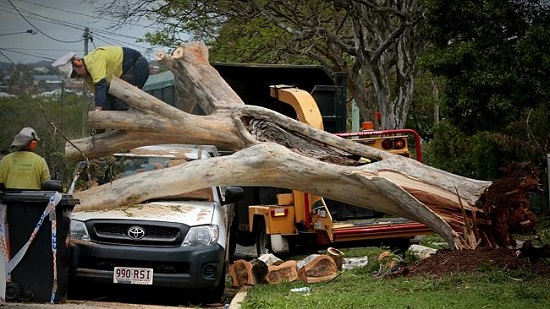
I was 11 floors up in the T&G building when it struck. There was a roar as the hail, some say as big as oranges, bounced off the rooves below.
The cleanup bill of up to $150 million compares to the storm of 1985, which is said to have cost $300 million. Certainly it was not as severe as the tornado-like storm that hit The Gap in 2008.
I heard today that 208 Energex crews were out re-establishing power. We were just fine in Ashgrove. Wind and rain, but no hail.
See also Brisbane storm: why was it so bad?
3. Victoria’s election
Most pundits and the polls suggest Labor will win, but Morgan has the LNP in a late surge and it could come down to a handful of votes in a handful of seats.
There is also interest in the upper house with Labor and The Greens playing silly buggers with preferences:
Complex tactical preference deals struck by Labor and the Greens have angered some progressive minor parties, which feel votes should rightfully flow to them.
The Greens have preferenced the Palmer United party relatively highly in some regions, while Labor has preferenced Family First above a selection of left-wing candidates in some regions and has placed the pro-hunting Country Alliance above all other parties in eastern Victoria.
The Shooters and Fishers party could win a seat in Victoria’s eastern division, due to favourable preferences, while the Greens have preferenced the Sex party highly in the northern metropolitan division, despite the party’s stated support in the past for the controversial East West toll road, which the Greens oppose.
The final makeup of the upper house is likely to prove an interesting negotiating challenge for Labor if it does manage to oust the Coalition government.
4. Right wing warriors turn on Abbott
Andrew Elder had some interesting things to say about politics and the media with special reference to the ABC. The adults are definitely not in charge.
Now Janet Albrechtsen, Andrew Bolt and Alan Jones have all turned on Abbott.
Abbott just can’t put a foot right. Laura Tingle on Thursday:
Prime Minister Tony Abbott finds himself defending the indefensible, or the already mortally-wounded, on three different fronts.
First, the government’s budget strategy is dead, a seriously ex-parrot, and we are left just going through the excruciating process of seeing how it is brought to account in next month’s mid-year budget review.
Yet the government persists – for now – with the fiction that it will all come good in the end.
Second, the prime minister’s credibility has been shattered, not just by a series of broken promises that have emerged through the year but by what one of his own backbenchers described as Abbott’s “verbal gymnastics” in trying to suggest that he had not broken any promises. The cut to ABC funding has crystallised voter disgust at such gymnastics.
Finally, the only thing that stopped an increasingly confident attack by the Opposition on the collapsing edifice of the budget bottom line and the Prime Minister’s trust deficit with voters was the spontaneous combustion of Defence Minister David Johnston when he declared on Tuesday that he would not trust the Australian Submarine Corporation to “build a canoe” . This opened up a whole new front of Labor attack on ministerial competence.
Since then the status of the $7 Medicare co-payment has depended on which minister you ask. What is definite is that they want sick people to go to the doctor less and they’ll try to find a way of making that happen!
When the photographers start piling in on you, you know you’re in trouble!
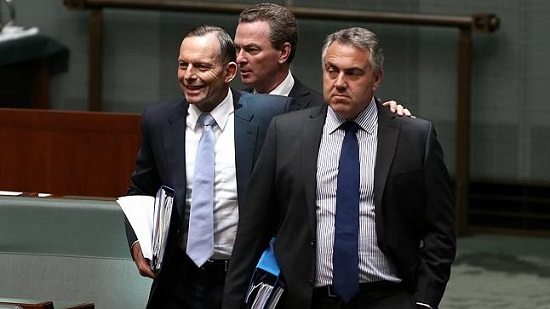
A failure of ambition: the UNEP Emissions Gap Report:
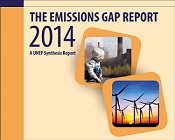
The United Nations Environment Programme (UNEP) has published its Emissions Gap Report 2014 a couple of weeks before the UN Conference on Climate Change in Lima, Peru. The latter is the annual UNFCCC Conference of Parties (COP), the penultimate one before the 2015 conference in Paris where, with a bit of luck, legally binding medium and long-term targets will be set for each country for emissions reduction. Each year since Copenhagen in 2009 the UNEP has reported on the gap between explicit pledges made by member states and what is required to have a likely (67%) chance of the planet staying within the 2°C guardrail. This is a necessary activity, because since Copenhagen each country determines its own targets within a framework of “common but differentiated responsibility”, which is a bunch of words that effectively allow each country to do as it pleases.
Someone needs to keep a tally as to what all this voluntary activity adds up to. UNEP had taken on that role.
The UNEP report takes note of and is broadly consistent with the IPCC Synthesis Report. Hence it accepts the IPCC ‘budget approach’ which states that we have already emitted 1,900 gigatonnes of carbon dioxide (Gt CO2) from an allowable budget of 2900 Gt since the dawn of the industrial era, leaving an estimated remaining budget of just 1,000 gigatonnes of carbon dioxide (Gt CO2). That’s roughly 20 years worth of emissions at the current rate.
Whereas the IPCC has given a range of scenarios, (scientists giving a range of options to policy makers) the UNEP has plotted just one which sees us peaking within about 10 years, halving CO2 emissions by 2050 and reaching net zero thereafter, they say between 2055 and 2070.
Net zero implies that some remaining CO2 emissions could be compensated by the same amount of carbon dioxide uptake, or ‘negative’ emissions, so long as the net input to the atmosphere due to human activity is zero, the report finds.
Because this scenario involves overshoot we will have to have net negative emissions during the last decades of the century. The less we act now the harder it gets later, as illustrated here:
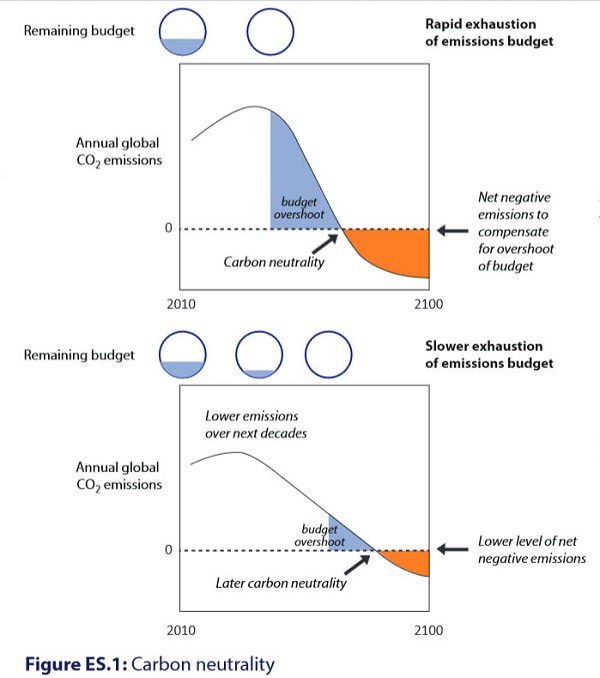
Hopefully this will sink into the brains of those attending the Lima conference, and more importantly the brains of their masters back home.
UNEP have done the sums and find that emissions in 2020 should not be higher than 44Gt CO2e to have a 67% chance of staying within
the 2°C target. If countries honour their current pledges we are heading for 52–54 Gt CO2e in 2020, leaving a gap of 8–10 Gt CO2e.
UNEP then looked at whether countries were on track to honour their pledges.
After reviewing available evidence from the G20 (with the EU 28 taken as a group) it appears that five parties to the United Nations Framework Convention on Climate Change – Brazil, China, the EU28, India and the Russian Federation – are on track to meet their pledges. Four parties – Australia, Canada, Mexico and the USA – are likely to require further action and/or purchased offsets to meet their pledges, according to government and independent estimates of projected national emissions in 2020. Conclusions are not drawn for Japan, the Republic of Korea, Indonesia and South Africa because of various uncertainties, nor for Argentina, Turkey and Saudi Arabia because they have not proposed pledges.
In 2010 we were at 49Gt CO2e; in 2020 we are likely to be at 55 Gt CO2e. The broad situation out to 2030 is represented as follows:
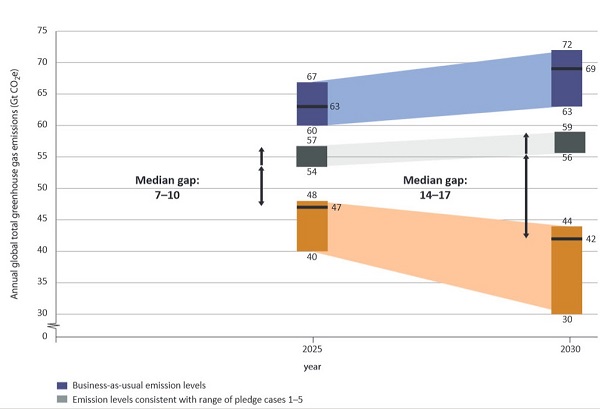
I take it that our current form will get us to 56 to 59 Gt CO2e (grey), whereas we should at the very least be at 42 Gt CO2e (in the orange zone).
The gap is still widening.
There are several comments that need to be made.
First, the UNEP calculations would not have taken on board the China-US agreement. As stated in that post, Climate Interactive worked out that if other countries matched the US-China effort the following stabilisation scenario would ensue:
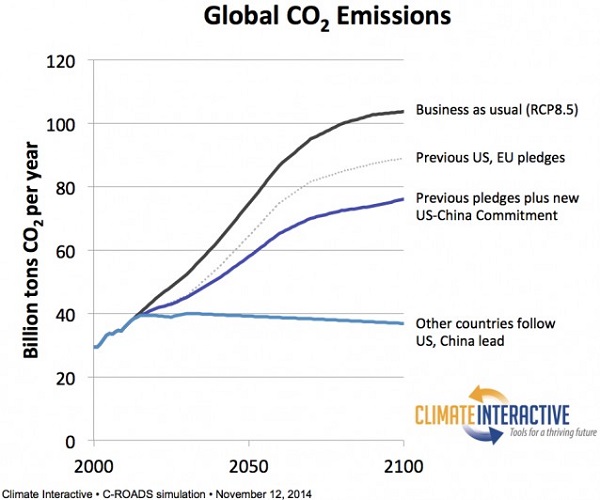
For the first time we have a prospect of peaking emissions, but this does not come within a bulls roar of zero emissions in the second half of this century. The current level of ambition is lamentably lacking.
Secondly, and admirably, the UNEP report takes into account all greenhouse gases from all sources, calculated in terms of CO2 equivalent. Too often scientific reporting is limited to fossil fuel emissions.
Thirdly, the report is conceived within a framework that is irresponsible, bordering insane. A 67% chance of not breaching the 2°C guardrail represents lousy odds when we are dealing with the viability of major ecosystems on the planet and the future of civilisation.
The 2°C guardrail itself is now clearly inappropriate, when, for example as I explained in this post and elsewhere that preserving more than 10% of coral reefs worldwide in 2100 would require limiting warming to below 1.5°C.
The World Bank report Turn down the heat contains examples like this:
In Brazil, at 2°C warming, crop yields could decrease by up to 70 percent for soybean and up to 50 percent for wheat.
The scientists from the Potsdam Institute for Climate Impact Research and Climate Analytics who put that report together for the World Bank are telling it like it is. Sadly the international array of scientists and others involved in the UNEP report (plenty of Germans but none I can see from Potsdam) are making concessions to what they think will be politically acceptable and doable, as, unfortunately, does the IPCC report.
The stakes are too high for such dissembling diplomacy!
Update: Len @ 1 asked:
It would be nice to at least know what level of action is needed to reach a 95% level surety. Is this stated anywhere?
Back in 2008 James Hansen told us that we had already overshot and that in the first instance we should get concentration levels down to 350 CO2e. Hower, he seems to be about a decade ahead of the bulk of the scientific/political community concerned with climate change. The 2°C guardrail had been invented by the Germans in the 1990s and was accepted by the UNFCCC process as a desirable aim in Copenhagen in 2009. Since then it has become the ‘widely accepted standard’ we should aim at. As such it provides the framework within most climate mitigation scientists work.
The IPCC Fifth Assessment report (AR5) (my post on the Synthesis Report here – see second table) did not look at stabilisation scenarios aiming at less than 450 ppm CO2e. They have a column for <430 but didn't fill it in, because of a lack of studies in the scientific record. The IPCC relies on studies in the scientific literature, with a cutoff of about December 2012, and insufficient studies were available for them to fill in the numbers. So the failure is with the scientific community, sadly. I can give you two pointers. The first is this wondrous graph which I first picked up in The Climate Authority Review of targets:
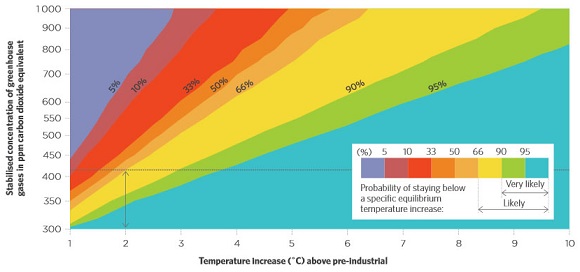
The graph has Malte Meinshausen’s name on it. He was at the time at the Potsdam Institute, I believe he is now at the University of Melbourne. His work is excellent.
From the graph you can see that 350 ppm will only get you about a 95% chance of staying below 2.5°C, not 2°C.
If you want a 1.5°C climate you need about 320 ppm. We are currently at 480 ppm CO2e.
It is notable that David Spratt and Philip Sutton wrote in 2008 that we should be aiming at 320 ppm. Spratt blogs at Climate Code Red, where under Publications you will find a book by the same name which was originally published online in 2008 as The Big Melt written in response to the astonishing Arctic melting in 2007, since easily surpassed in 2012. Spratt is a science writer rather than a scientist, and consistently publishes critiques of the mainstream approach, as I picked up, for example in The game is up, where he says:
We have to come to terms with two key facts: practically speaking, there is no longer a “carbon budget” for burning fossil fuels while still achieving a two-degree Celsius (2°C) future; and the 2°C cap is now known to be dangerously too high.
He concludes that there is no longer a non-radical option, only one path remains viable: the emergency ‘war economy’ mode.
Climate Code Red identifies practical strategies we need to adopt.
The Australian group Beyond Zero Emissions consistently publish material on rapid decarbonistaion. My mate John Davidson has investigated them more than I have and regards them as sound. I hope to post on one of their reports soon.
Elsewhere Kevin Anderson from the UK is worth keeping an eye on. See his personal site and Real clothes for the emperor.
Professor John Wiseman, Deputy Director of the Melbourne Sustainable Society Institute at the University of Melbourne looked at the shape of climate policy for the future for the Centre for Policy Development. See Climate change: reconnecting politics with reality. He has an appropriate sense of urgency and sets out the specific strategies we need to adopt in Australia for rapid decarbonisation. He, for example, sees the need for 100% renewables in 10 years.
People like Spratt, Anderson, Wiseman and BZE are all looking for “the achievement of emission reductions at the necessary scale and speed [which] will require transformational rather than incremental change”. The war analogy is not inappropriate. Abbott would have us fiddle while Rome burns. His approach is essentially one of tokenism. You run a climate mitigation program off to one side in order to have one on your books, at the least expense you can get away with. It’s essentially a sop to the electorate which doesn’t interrupt your central vision of the generation of wealth based centrally on the fossil fuel industry.
This is delusional – see The folly of Galilee basin coal.
Climate clippings 115
1. Australia’s coal and gas exports are being left stranded
Just four countries account for 80% of Australia’s fossil fuel exports – China, Japan, Korea and India.
China is on the verge of “peak coal”, rebalancing the economy away from energy intensive industry and introducing a national emissions trading scheme.
Japan is on an energy efficiency drive to reduce its fuel import bill.
Korea has introduced a tax on coal of AU$18 per tonne and is finalising an emissions trading scheme.
India has doubled its tax on coal which funds renewable energy projects and has signalled its intention to stop importing coal within 2-3 years.
Official forecasts are in denial.
2. Are Australian and US climate targets the same?
Environment minister Greg Hunt, Radio National, November 17:
If you use the full Kyoto period — 1990 to 2020 — the US is minus 5% and Australia is almost exactly the same.
Joe Hockey made a similar statement that “If you compare apples with apples, the American position and our position on reductions are effectively the same.”
The comparisons are complex, because the starting and finishing dates are different, so are the population increases. Moreover Australia has forestry and tree clearing in the mix.
Malte Meinshausen and Anita Talberg make the necessary adjustments and find:
An apples-with-apples comparison shows that Australia lags far behind the United States in efforts to reduce greenhouse gas emissions from its energy, transport and industrial sectors.
To match US efforts, Australia would have to increase its 2020 ambitions from the current 5% below 2000 to 21% or even 29%, depending on whether different population growth is taken into account, or not.
In short, they lie!
3. The genius of Tony Abbott’s stance on climate
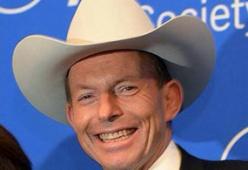
At New Matilda Tom Allen comments on Tom Switzer’s claim the Abbott is a climate change genius. Switzer is a climate change denialist, so we won’t bother with that! Allen finds Abbott has proved one thing – that a carbon tax works!
Abbott
will be remembered as the Prime Minister who proved that the carbon tax worked. After it was introduced, Australia’s carbon dioxide emissions fell, the economy continued to grow and the sky remained in place.
When Abbott repealed it and the country’s emissions began to rise again, using Australia as a vast laboratory, Abbott confirmed it: carbon taxes work.
4. Record growth in electricity sector emissions
Abbott’s genius is demonstrated by this graph of emissions change from electricity production:
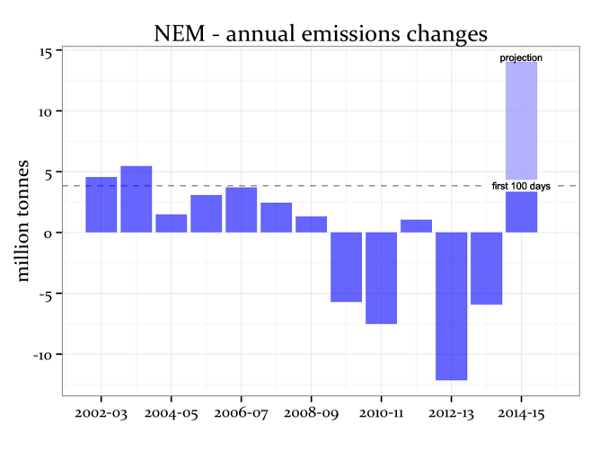
The reductions started well before the carbon ‘tax’, but whatever the reason Abbott seems to have made a difference.
WORST. PRIME MINISTER. EVER!!
As Tom Allen said, it’s nothing personal.
The worst things about him are his policies, and his stance on climate change is worst of all.
5. Record-breaking ocean temperatures
The world’s oceans are the hottest they’ve ever been in the modern record, especially in the northern Pacific.
In July this year, ocean surfaces were 0.55 °C above the average since 1890, just beating the previous record of 0.51 °C in 1998. In the North Pacific, the temperatures were about 0.8 °C above average, which is 0.25 °C warmer than the 1998 peak.
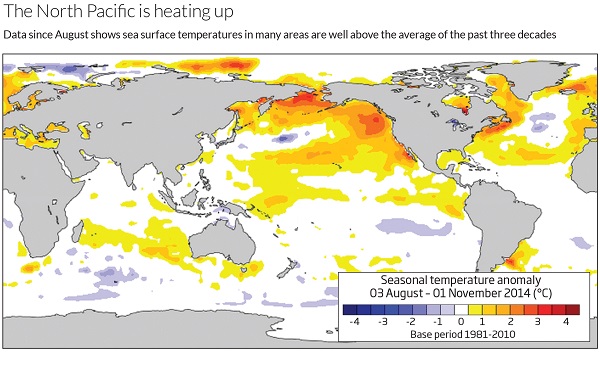
No explanation is given as to why this pattern has emerged. However, it does seem to be disrupting the development of an El Niño. Small mercy, because the northern Pacific warming has effects similar to an El Niño:
This includes more hurricanes in the Pacific, as well as more storms curling over into mainland US. Meanwhile, there have been fewer hurricanes in the Atlantic, just as happens during El Niño. Elsewhere, dry conditions have occurred across Australia, and the Indian monsoon was delayed – effects all arising from warm oceans, despite the lack of an El Nino event.
6. Turn down the heat : confronting the new climate normal
This is volume 2 of 2 of a report prepared for the World Bank by the Potsdam Institute for Climate Impact Research and Climate Analytics, and hence highly authoritative. The lead author was Hans Joachim Schellnhuber of the Potsdam Institute.
It’s a massive 320 page report. This is from the Foreword:
There is growing evidence that warming close to 1.5°C above pre-industrial levels is locked-in to the Earth’s atmospheric system due to past and predicted emissions of greenhouse gases, and climate change impacts such as extreme heat events may now be unavoidable.
As the planet warms, climatic conditions, heat and other weather extremes which occur once in hundreds of years, if ever, and considered highly unusual or unprecedented today would become the “new climate normal” as we approach 4°C—a frightening world of increased risks and global instability.
The consequences for development would be severe as crop yields decline, water resources change, diseases move into new ranges, and sea levels rise. Ending poverty, increasing global prosperity and reducing global inequality, already difficult, will be much harder with 2°C warming, but at 4°C there is serious doubt whether these goals can be achieved at all.
That’s about as far as I could get tonight. Climate Progress has a post.
ABC cuts run deep – over 400 jobs to go
The ABC has announced that more than 400 ABC staff could lose their jobs as the public broadcaster moves to implement the $254 million the Federal Government will cut over the next five years. That’s $254 million out of an otherwise projected budget of $5.5 billion.
I’d like someone to do an historical perspective on this. My memory is that in the 1980s the ABC had 6000 staff. There were cuts during the Hawke-Keating years. I heard yesterday that Costello’s first budget saw cuts of 12%. The Howard years were not kind to the ABC, not receiving any of the largesse distributed in the good years. The Rudd-Gillard years actually saw some improvement in the ABC budget, mostly through negotiated support for additional services. Supporting a strong and vibrant public broadcaster was part of ALP policy. At the same time the ABC did Labor no favours in its reporting.
That’s from memory. I’d like to see a proper study.
I’ll come to broken promises later. First some detail on the cuts:
- Adelaide TV production studios to close
- State-based 7.30 programs on Friday to be scrapped and replaced with national 7.30 program
- Lateline moved to a new timeslot on ABC News 24
- Foreign bureaux will be restructured to create “multiplatform hubs” in London, Washington, Jakarta and Beijing, although the number of correspondents will stay the same
- The Auckland bureau will close down and a new Beirut post will be opened
- Regional radio posts in Wagin, Morwell, Gladstone, Port Augusta and Nowra to close
- ABC Local, Radio National and ABC Classic FM programming changed, with some programs scrapped
- State-based local sports coverage scrapped
- The creation of a new regional division and ABC Digital Network, to begin in mid-2015, and a $20 million digital investment fund.
Radio National’s Bush Telegraph will be scrapped. I used to listen to it to keep in contact with happenings in the bush. In recent years I’ve favoured Richard Fidler’s excellent and compelling Conversations, which clashes in the timeslot.
In another blow against the bush, Local Radio Afternoons programs will go state-wide. In Queensland that will likely be Kelly Higgins-Devine, who has lived in the far north and will do a good job. It’s just not the same. There is a lack of localism, evident at times when Brisbane has had to be combined on a temporary basis with the Gold Coast and the Sunshine Coast.
Apparently 100 internet sites are to be closed, which sounds like a real blow to ABC’s generally excellent internet presence. Presumably there will be fewer transcripts of radio and TV programs, which will be a loss.
Managing Director Mark Scott told Leigh Sales that at least 10% of the 10% would be administrative or support staff. As to why a 5% cut translates into a 10% staff cut, Scott didn’t answer very well but I think the story lies in fixed infrastructure costs.
As to broken promises, the only thing worse that breaking a promise is pretending that you didn’t. ABC’s FactCheck verdict is This promise is broken. It was all very clear:
During a live interview with SBS from Penrith football stadium, Mr Abbott said: “No cuts to education, no cuts to health, no change to pensions, no change to the GST and no cuts to the ABC or SBS.”
Turnbull has been saying:
“Prior – prior to the election, I said on a number of occasions, I think possibly on this show, certainly on Lateline, that while we weren’t planning to make, you know, massive, slashing cuts to the ABC to cut their programming resources, as some people were urging us to do so, we would be looking to make… savings and cut waste right across government and ABC and SBS would not be exempt,” he said.
To be honest, unless he can provide an actual quote I think that is a flat out lie. Certainly he said something along those lines after the election.
Overwhelmingly, I think Ben Eltham is right, it’s about revenge – punishing the perceived enemies of the right.
There has been an appalling associated decision – Janet Albrechtson has been appointed to a panel to oversee the appointment of board members. There can be no clearer sign of a desire to domesticate the ABC.
Scott himself is apparently too much of a leftie. Turnbull has suggested that he relinquish the role of editor-in-chief. I think overall editorial and resource allocation roles are not usefully separated.
This attack on the ABC was of course expected. In it’s conception and execution, however, it has exceeded my expectations of brazenness and perfidy.
What do scientists think about the Great Barrier Reef?
That’s the question Leigh Sales should have been asking rather than playing prompt to Julie Bishop’s spin on the 7.30 Report.
I’ve been citing a 2011 study by K. Frieler et al which found that:
preserving more than 10 per cent of coral reefs worldwide would require limiting warming to below +1.5°C (atmosphere–ocean general circulation models (AOGCMs) range: 1.3–1.8°C) relative to pre-industrial levels.
What President Obama and the Chinese are doing is not nearly enough to save the Great Barrier Reef, and there’s a fair chance that Obama knows it.
The ABC news bulletins have simply been repeating the Government lines without asking Opposition spokespeople, let alone scientists. The Guardian did better:
Bishop said on Friday the government did not believe the reef was in danger – a comment that contradicts the scientific consensus that it is.
The 2014 outlook report from the Great Barrier Reef Marine Park Authority said: “Climate change remains the most serious threat to the Great Barrier Reef. It is already affecting the reef and is likely to have far-reaching consequences in the decades to come.”
Radio National’s PM program in a segment not picked up by their news outlets interviewed Dr Jon Brodie from James Cook University who was the lead author of a 2008 scientific report for the Queensland Government on water quality issues affecting the Great Barrier Reef, and last year completed a Scientific Consensus Statement based on the views of more than 50 scientists and policy experts. He cites the Australian Government’s own outlook report 2014 linked above which:
says very clearly that the reef is in poor condition and continuing to deteriorate, and that major actions are needed to stop that deterioration.
Bishop says that the people who look after the reef are following the world’s best practice. Brodie says that’s irrelevant because what they are doing is ineffective:
The reef’s lost half its coral, it’s lost most of its dugong, seagrass is in poor condition. Most of the major indicators of the reef are in a serious state and serious state of decline. And hence, whatever management we are doing now, whatever standard it is, it’s not enough.
The Queensland and Federal governments have come out with a draft Reef 2050 Sustainability Plan to address the reef’s decline but Brodie describes it as “very weak”.
The bottom line?
the Government’s own report on the reef, very clearly says that climate change is a major issue for the reef. And if we don’t do anything about it, somebody doesn’t do something about it, then there’s not really a lot of hope to have the reef restored to its, you know, good value.
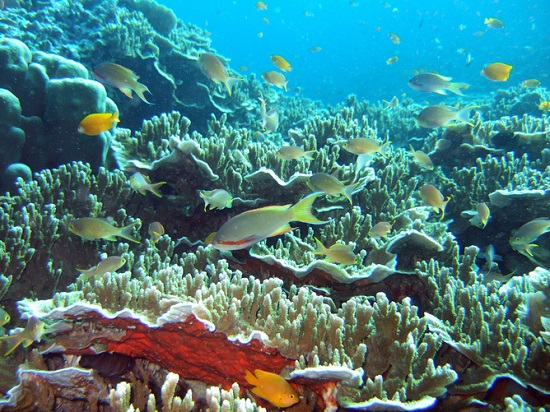
The SMH asked several scientists including Brodie, Dr Ove Hoegh-Guldberg, Director of the Global Change Institute at The University of Queensland and Dr Charlie Veron, a former chief scientist at the Australian Institute of Marine Science.
Ove Hoegh-Guldberg was involved in the Frieler research cited above and stressed the dangers of ocean acidification. In 2012 he wrote an article for The Conversation pointing out the inappropriateness of the 2°C guardrail for preserving coral reefs.
Veron was blunt:
“In the long term, that is the whole of this century, we are going to have the Great Barrier Reef slaughtered,” Dr Veron, a world authority who has scientifically named about one-quarter of all known corals, said.
“There’s no doubt about that at all, if carbon-dioxide emissions keep on tracking as they are.”
Currently UNESCO is undertaking a review of the Great Barrier Reef’s World Heritage status, due for completion by mid-2015.
Both Brodie and Veron see the Queensland and Australian governments in a frenzy to head off an ‘endangered’ listing. It was pointed out on the ABC Insiders program that such a listing would inhibit the financing of planned developments.
Obama is right to worry what his granddaughters will see if they come to visit. It’s possible there will still be something worth crossing the Pacific for. Chances are, however, that his great granddaughters will stay at home.
It’s all very simple really – Government spin versus very real concern by scientists, a threat to UNESCO World Heritage listing with flow-on effects on development, and international goals for a 2°C guardrail which will see the reef destroyed.
Simpson Desert crossing 6: Day 5
Margot was up early, grabbing a coffee and warming herself with the already rekindled fire: Continue reading Simpson Desert crossing 6: Day 5
Saturday salon 22/11

An open thread where, at your leisure, you can discuss anything you like, well, within reason and the Comments Policy. Include here news and views, plus any notable personal experiences from the week and the weekend.
For climate topics please use the most recent Climate clippings.
The gentleman in the image is Voltaire, who for a time graced the court of Frederick II of Prussia, known as Frederick the Great. King Fred loved to talk about the universe and everything at the end of a day’s work. He also used the salons of Berlin to get feedback in the development of public policy.
Fred would only talk in French; he regarded German as barbaric. Here we’ll use English.
The thread will be a stoush-free zone. The Comments Policy says:
The aim [of this site] is to provide a venue for people to contribute and to engage in a civil and respectful manner.
Here are a few bits and pieces that came to my attention last week.
1. PUP politics
Unless you were under a rock you’d know that PUP politics got worse.
After PUP expelled Jacqui Lambie’s chief of staff Rob Messenger from party Lambie and Ricky Muir broke ranks to join a ‘coalition of common sense’ against the financial advice laws.
Then Lambie was removed as deputy Senate leader and deputy whip of the party for failing to attend three party meetings.
The slanging match continued with Palmer calling Lambie a liar.
Now the ABC says Clive Palmer stormed out of an interview with Emma Alberici when she got onto the Chinese court matter. I watched the interview and would say Palmer terminated it rather that stormed out. As Palmer says, wait for the court judgement.
The bottom line is that it looks as though Jacqui Lambie is on her way out, but this still leaves PUP with the balance of power in the senate if the arrangement with Ricky Muir hold up.
2. Authorisms
‘Authorisms’ are neologisms coined by authors which have entered the wider language. Did you know that Billy Shakespeare invented words like bump, hurry, critical, and road? Now Paul Dickson chooses his top 10.
-
1. Banana Republic invented by O. Henry (William Sidney Porter) in 1904.
- 2. Beatnik – columnist Herb Caen in 1958.
- 3. Bedazzled – Shakespeare in Taming of the shrew.
- 4. Catch-22 – Joseph Heller 1961.
- 5. Cyberspace – novelist William Gibson in 1982.
- 6. Freelance – Sir Walter Scott in Ivanhoe.
- 7. Hard-Boiled – Mark Twain in 1886.
- 8. Malapropism – Richard Brinsley Sheridan in 1775.
- 9. Serendipity – Horace Walpole in 1754.
- 10. Whodunit – book critic Donald Gordon in 1930.
3. The LNP government shoots itself in the foot, and the ABC
Also SBS, of course. The cuts to the ABC amount to around 5% over four years. Barrie Cassidy points out that big C conservatives will be pleased, but they’ll thank Abbott rather than Turnbull.
Turnbull looks a goose on two counts. Firstly, he defends Abbott for saying very directly before the election that there would be no cuts to the ABC and SBS. So he’s defending the indefensible.
Secondly, he says the cuts won’t amount to anything that matters.
And in any case collectively, they only had in mind cuts that would not reduce services. Clean cuts. Nice cuts. Cuts that can’t be seen with the naked eye.
If you believe that I’ve got a bridge you might like to buy.
Mark at The Monthly writes that any leftie love of Turnbull will now be over.
It should have been when Turnbull dicovered Godwin Grech. I’ll say more when we have the ABC response.
Ben Eltham says it’s revenge, pure and simple.
4. Anthony Albanese said it in 1996
Courtesy of Mark’s Facebook:
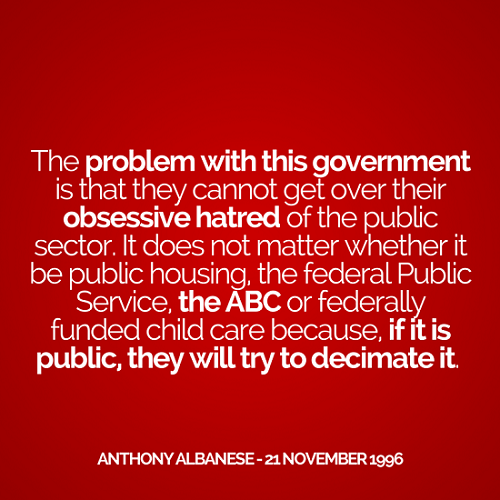
Hundreds of people have turned out to pay tribute to former ‘hero’ Queensland Labor premier Wayne Goss at a public memorial service in Brisbane.
Mr Goss was known as ‘Mr 70 Per Cent’ for his high public approval rating during his time as Queensland premier.
He died at the age of 63 at home in Brisbane in the early hours of November 10 from a recurrent brain tumour.
David Barbagallo pays tribute.
6. ALP competitive in two states
Galaxy poll has the ALP and the LNP at 50-50 in Queensland, 52-48 in Victoria.
Climate clippings 114
1. Ocean acidification charted
Apparently there has been no baseline data for ocean acidification, which varies around the world. Now a database of the current state of the ocean has been compiled. Here is a map showing the rough state of play:
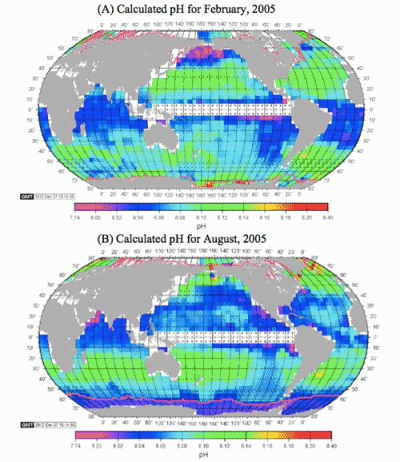
The current rate of acidification for the ocean is the greatest seen in the past 300 million years. 25% of co2 emitted ends up in the ocean.
This article offers some hope that some species may adapt.
2. Warmest October
NASA has October as the warmest since 1880 along with 2005. The Japanese Meteorological Agency has it as the warmest ever:
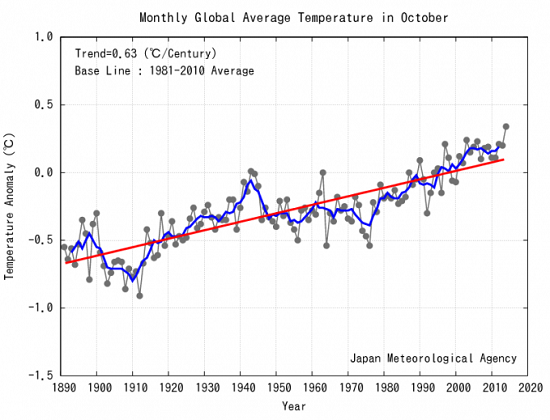
No warming pause there!
So far an El Niño still has not developed, which would make things warmer.
3. Climate Council report fingers us
The Climate Council has published a new report Lagging Behind: Australia and the Global Response to Climate Change. The key findings are:
- China and the US have firmly moved from laggards to global leaders on climate change.
- In the last five years most countries around the world have accelerated action on climate change as the consequences have become more and more clear.
- Australia, a crucial player in global climate action, moves from leader to laggard.
- Global action must accelerate to protect Australia and the world from the consequences of a changing climate, sea level rise and more frequent and intense extreme weather.
Now, 39 countries and over 20 sub-national jurisdictions are putting a price on carbon. China has the world’s second largest carbon market with 250 million people covered. In the US 10 states have carbon markets, covering 79 million people.
Germany has decoupled growth from carbon pollution. Since 1990 GDP has increased 37% while emissions have fallen 25%.
According to the IEA and the OECD for every $1 spent to support renewable energy, another $6 is spent on fossil fuel subsidies, but investment in renewable energy at US$192 billion now exceeds that in fossil fuel energy at US$102 billion.
Australia is the 15th largest emitter out of 186 countries. We emit roughly the same as France, Italy and Turkey, each with three times the population.
Here’s the world wide solar growth:
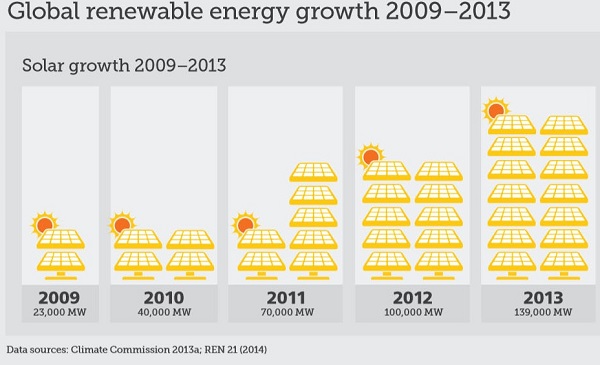
Our record on large scale renewables:
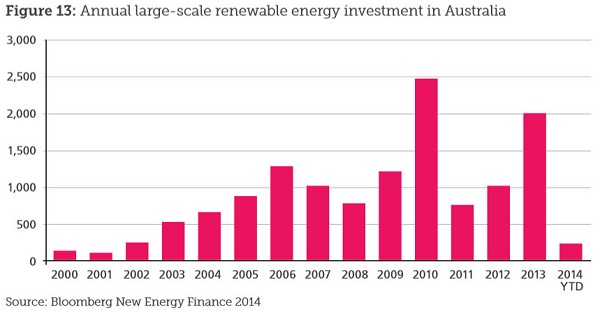
Time to get on our bike!
4. Climate Council on renewables
The Climate Council report finds that around the world important initiatives on renewables are often taken at the sub-national level. In Australia:
- South Australia is striding forward leading the Australian States on renewable energy.
- Victoria and NSW have moved from leaders to laggards in Australia’s renewable energy race.
- Australia has substantial opportunities for renewable energy. A lack of clear federal policy has led to a drop in renewable energy investment.
Only SA and the ACT have renewable energy targets – SA 50% of electricity by 2025, the ACT 90% by 2020. The current state of play is:
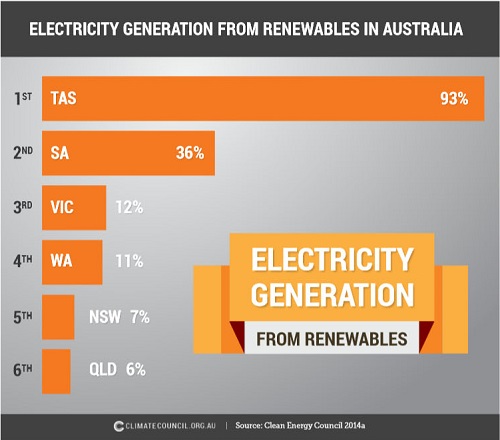
SA narrowly pips QLD in terms of percentage of dwellings with solar PV:

Both have roughly a quarter.
The potential for renewables in Australia is huge – some 500 times current electricity generation.
Australia produces per capita 23.96 tCO2e as against an OECD average of 12.47. As I said, time to get on our bike!
5. China caps coal use by 2020
The Chinese government announced Wednesday it would cap coal use by 2020. The Chinese State Council, or cabinet, said the peak would be 4.2 billion tonnes, a one-sixth increase over current consumption.
This is a staggering reversal of Chinese energy policy, which for two decades has been centered around building a coal plant or more a week. Now they’ll be building the equivalent in carbon-free power every week for decades, while the construction rate of new coal plants decelerates like a crash-test dummy.
The 2020 coal peak utterly refutes the GOP claim that China’s recent climate pledge “requires the Chinese to do nothing at all for 16 years.” Indeed, independent analyses make clear a 2020 coal peak announcement was the inevitable outcome of China’s game-changing climate deal deal with the U.S. last week, where China agreed to peak its total carbon pollution emissions in 2030 — or earlier.
6. Australia a pariah
Giles Parkinson thinks other nations are deliberately trying to embarrass Australia on climate change. Certainly Obama’s remarks can be interpreted that way. Then he (Giles) really gets stuck in:
We are, quite possibly, witnessing the most incompetent and ideologically blind government ever to hold power in Canberra. It’s effectively the Tea Party of Australia, pretending to be something else.
G20 goodness
Overall when I think about the Brisbane G20 I’ll think about Putin not being shirt-fronted and leaving the instant the conference was over, about president Obama putting climate change front and centre in peoples minds, deserted streets and empty cafes, masses of coppers, 6000 of them, and traffic gridlock from here to the Gold Coast as people took advantage of the long weekend.
Yes, Brisbane welcomed the pollies and thousands of journalists by getting the hell out of here.
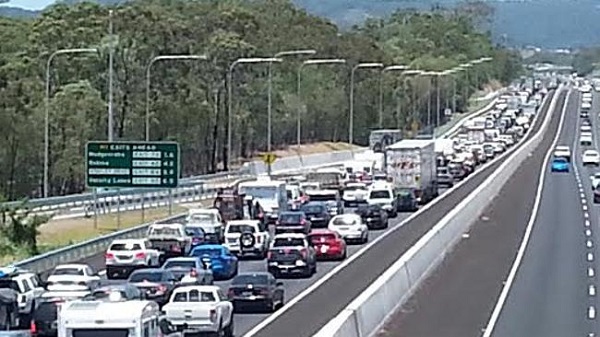
As to Abbott’s role in the G20, Paul Syvret in the Courier Mail summed it up perfectly (thankyou John D!):
TAKE a bow ’Straya. You showed the world, when given the opportunity to shine on a global stage of grand ideas, just how small-minded and insular we can be.
Sure, we hosted a meeting of G20 leaders that went off without a logistic hitch or any ugly civil unrest or security incidents. Well done us.
The vision and inspirational leadership side of the equation though left a bit to be desired.
Less than a week after the United States and China announced a landmark agreement to tackle climate change, Australian Prime Minister Tony Abbott opened proceedings at the G20 summit by boasting how Australia had abandoned its carbon-pricing scheme.
He also, literally, thanked God that we have stopped the “illegal boats” – in the company of people like Italian Prime Minister Matteo Renzi, whose navy earlier this year rescued more than 3500 seaborne asylum seekers in one 48-hour period.
Then for good measure, he moaned to the world’s most-powerful leaders about his failure to get a $7 Medicare co-payment through the Senate; parish pump pissantery in front of the likes of US President Barack Obama, whose administration went to the brink of international debt default thanks to a gridlocked Congress.
A columnist for the LA Times described it as “an awkward, pimply youth moment so embarrassing that it does sting”.
Australia, she wrote, is “the adolescent country. The bit player. The shrimp of the schoolyard.”
“The Group of 20 summit could have been Australia’s moment, signalling its arrival as a global player … but in all, the summit had Australians cringing more than cheering.”
Bill Shorten dubbed Abbott as “weird and graceless”.
Compare Barack Obama’s visionary eloquence, laying down the gauntlet on climate change and announcing a US$3 billion contribution to the Green Climate Fund. His speech if you missed it is here.
Ironically there was a point to Abbott’s whingeing about the $7 Medicare co-payment. If you ask Joe Hockey, he’ll tell you G20 was about growth, 2 trillion dollars of it, in 862 concrete proposals put forward by the G20 countries. Apparently Australia’s bright ideas for growth included wrecking Medicare and ripping 20% of funding out of our universities. Fair dinkum! Makes you wonder about the other 860 ideas!
Another point is that the ideas for growth were supposed to be ideas that the governments would not otherwise have done. However, I understand the gun went off in February in preparation for the G20 finance ministers meeting in Cairns in September. Are we really to believe that the Abbott government would have left Medicare and universities alone in the 2014 budget, but for G20?
It must be said that the Brisbane G20 was well organised from every viewpoint. The G20 Leaders’ Communiqué, 21 points in three pages of text, plus lists of supporting documents, is mercifully succinct. Of course it was written and circulated beforehand. Climate change was always going to be there (para 19) because a Climate Finance Study Group had been set up at an earlier meeting.
By the way the Abbott government does not support the Green Climate Fund, designed to assist developing countries, and apparently won’t contribute. Our share, pro rata, should be a mere $200,000 or so.
The G20 spawns a large number of sub-groups. Apart from the finance ministers and central bankers, trade ministers have met and now energy ministers will follow suit. There is a Financial Stability Board and a G20 Food Security and Nutrition Framework, for example. As a decision of this meeting a Global Infrastructure Hub will be established in Sydney to facilitate infrastructure planning.
Around the G20 sit an alphabet soup of meetings hoping to influence the G20. The B20 meeting of business leaders is inside the tent in formal collaboration with the G20. By contrast an L20 group, I gather of labour unions, is ignored. A ‘women in leadership’ group was luckier. The G20 responded by (para 9) agreeing to a goal of
reducing the gap in participation rates between men and women in our countries by 25 per cent by 2025, taking into account national circumstances, to bring more than 100 million women into the labour force, significantly increase global growth and reduce poverty and inequality.
There was also a T20 organised by think tanks. In addition there was a Global Cafe, I think organised by the Brisbane City Council, which brought together “futurists and thought leasers”.
There were plenty of protests. For example, refugee advocates released paper boats on the Brisbane River and were ignored. I think Turkey, the next host, is going to put refugees on the agenda.
Aborigines shouted angry words and burnt effigies of Noel Pearson, Marcia Langton and Warren Mundine.
The police set up formal lines of communication with groups planning to protest and facilitated how they might do it. As a result there were only 14 arrests, compared I believe with 1300 in Toronto. It was unusual to see protesters praised by police on the telly. There was no property damage.
Those who thought that Vladimir Putin was comprehensively roasted by other leaders missed an informal meeting of BRICS (Brazil, Russia, India, China, South Africa) where Putin was supported and the sanctions declared illegal.
On climate change, Laura Tingle reckoned Obama delivered Abbott a lesson in power. Within the meeting according to The Age Abbott carried on like a pork chop, giving an impassioned defence of coal and opposing the goal of eliminating fossil fuel subsidies.
Enough said!
Elsewhere John Quiggin thinks hosting the G20 did nothing for Brisbane and was a waste of money. The notion that events like this “put Brisbane on the map” is silly.
I dunno! Perhaps Angela Merkel taking selfies in a Caxton Street pub will bring her many Tweet followers flocking to Brisbane!
ALP extends lead
They say that all politics is local. In any case Abbott’s ventures into international politics in APEC and the G20 seem to have done him no good. Newspoll has the ALP 10 points ahead (55-45) on a two-party-preferred basis, with Labor’s primary vote ahead of the LNP for the first time since July. Shorten has edged ahead in the better prime minister stakes 43-39 with 20% uncommitted. For the tables go here.
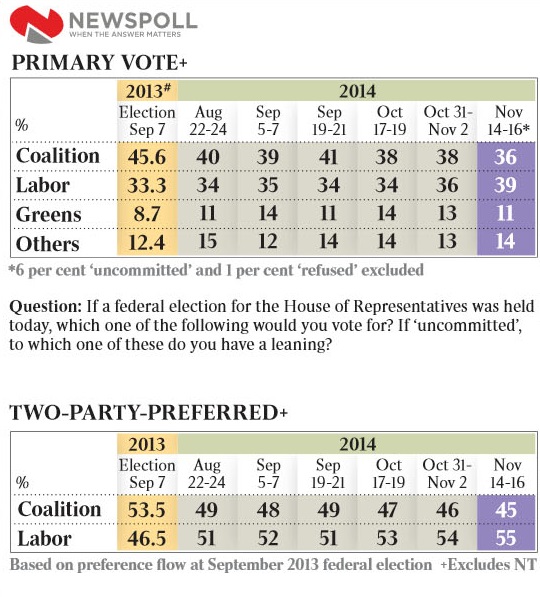
It’s the gap and the trend that is interesting. Morgan has a similar pattern, coming out at 55.5 – 44.5 for the ALP.
The only demographic where the LNP is ahead is now the over 65 year olds. The ALP leads in all states, even WA, but by less than the margin for error.
Morgan has PUP on a mere 2.5% nationwide and only 1.5 in Victoria.
A game changer? The US-China climate deal
Mother Jones thinks the deal is a game changer, so does Joe Romm at Climate Progress. Climate scientists what agree with some cautions, including the big one that it’s not nearly enough.
In the broad, China has agreed to peak emissions by 2030, the US will reduce emissions by 26 to 28% by 2025, relative to 2005.
Yet China will still be getting 80% of its power from fossil fuels in 2030.
They said China would never do a deal of significance, and the US could not make significant reductions politically while China did nothing. That’s why the deal is a game changer.
Now Republicans are saying that China is doing nothing for 16 years. That’s not true. China will install 800-1,000 gigawatts of nuclear, wind, solar and other zero emission generation capacity by 2030.
Joe Hockey implied that Obama will not deliver, because of an unfriendly Congress. Obama said on Sunday specifically that he is not relying on Congress for anything – he’ll do it without their help. Republicans are freaking out and will no doubt destroy the deal if they reclaim the presidency.
Given the unhelpfulness of Congress Obama’s plan is surprisingly ambitious, roughly doubling the pace of reductions:
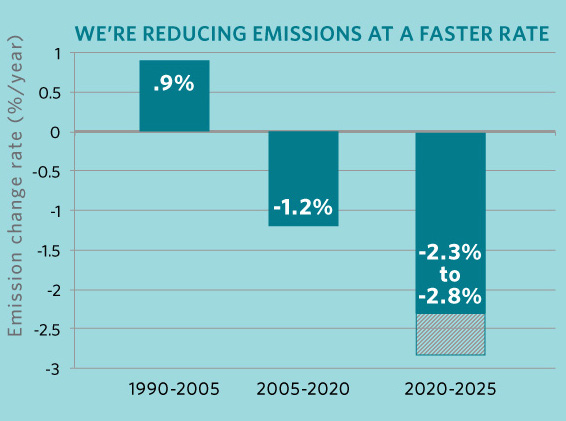
The overall impact is portrayed by this graph from Climate Interactive:

That would see emissions in 2100 roughly the same as they are now. According to the recent IPCC Synthesis Report most of the stabilisation scenarios you’d want to follow see zero emissions some time before 2100. You can get a rough idea of what’s required from this graph by Prof Hans Joachim Schellnhuber:
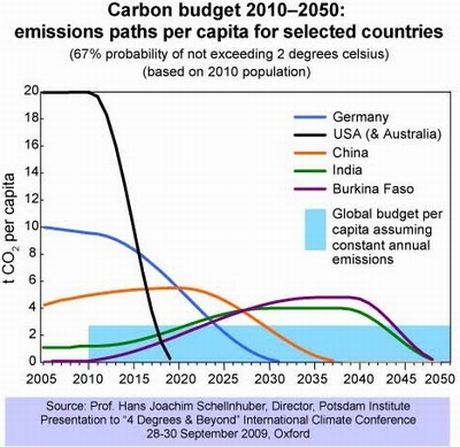
That is for a 67% chance of not exceeding 2°C.
With emissions trading that would be modified thus:
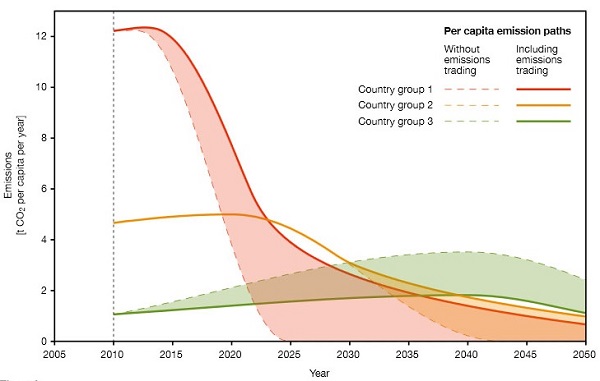
I would assume that China is a Group 2 country in this scenario.
At a rough guess, then, I suspect that China and the US are doing no more than half what they really should, if we assume that 2°C is OK, which I don’t.
Mother Jones lists some of the detailed items covered in the agreement:
- Expanding funding for clean energy technology research at the US-China Clean Energy Research Center, a think tank Obama created in 2009 with Xi’s predecessor Hu Jintao.
- Launching a large-scale pilot project in China to study carbon capture and sequestration.
- A push to further limit the use of hydroflourocarbons, a potent greenhouse gas found in refrigerants.
- A federal framework for cities in both countries to share experiences and best practices for low-carbon economic growth and adaptation to the impacts of climate change at the municipal level.
- A call to boost trade in “green” goods, including energy efficiency technology and resilient infrastructure, kicked off by a tour of China next spring by Commerce Secretary Penny Pritzker and Energy Secretary Ernest Moniz.
All good stuff. One valid criticism is that the agreement neglects the issue of adaptation, necessary because under the implied scenario warming will continue.
Our government has chosen to be a follower rather than a leader. It is now time to follow. But in doing so they should take a look at Prof Schellnhuber’s graphs to understand their true responsibility – and why buying carbon credits offshore is not such a bad idea.
To take the politics out of the issue they could even flick it to The Climate Change Authority. That’s what it was set up for.



